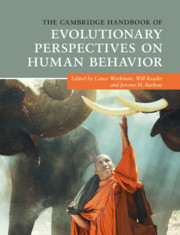Book contents
- The Cambridge Handbook of Evolutionary Perspectives on Human Behavior
- The Cambridge Handbook of Evolutionary Perspectives on Human Behavior
- Copyright page
- Dedication
- Contents
- Figures
- Tables
- Contributors
- Preface
- Acknowledgments
- Part I The Comparative Approach
- Part II Sociocultural Anthropology and Evolution
- Part III Evolution and Neuroscience
- Part IV Group Living
- Part V Evolution and Cognition
- Part VI Evolution and Development
- Part VII Sexual Selection and Human Sex Differences
- Part VIII Abnormal Behavior and Evolutionary Psychopathology
- Part IX Applying Evolutionary Principles
- 36 A Bridge Too Far?
- 37 The Evolution of Personality
- 38 Applying Evolutionary Principles to Criminality
- 39 Substitute Parenting
- 40 Historians and the Evolutionary Approach to Human Behavior
- 41 The Psychology of Extraterrestrials
- Part X Evolution and the Media
- Index
- References
39 - Substitute Parenting
from Part IX - Applying Evolutionary Principles
Published online by Cambridge University Press: 02 March 2020
- The Cambridge Handbook of Evolutionary Perspectives on Human Behavior
- The Cambridge Handbook of Evolutionary Perspectives on Human Behavior
- Copyright page
- Dedication
- Contents
- Figures
- Tables
- Contributors
- Preface
- Acknowledgments
- Part I The Comparative Approach
- Part II Sociocultural Anthropology and Evolution
- Part III Evolution and Neuroscience
- Part IV Group Living
- Part V Evolution and Cognition
- Part VI Evolution and Development
- Part VII Sexual Selection and Human Sex Differences
- Part VIII Abnormal Behavior and Evolutionary Psychopathology
- Part IX Applying Evolutionary Principles
- 36 A Bridge Too Far?
- 37 The Evolution of Personality
- 38 Applying Evolutionary Principles to Criminality
- 39 Substitute Parenting
- 40 Historians and the Evolutionary Approach to Human Behavior
- 41 The Psychology of Extraterrestrials
- Part X Evolution and the Media
- Index
- References
Summary
Evolutionary theory has straightforward relevance to parental behavior. The behavioral inclinations that natural selection favors are those that contribute to Darwinian fitness, that is, to one’s expected genetic posterity (in the statistical, not the psychological, sense of “expected”). The primary avenue by which people and other creatures promote their fitness is by producing viable young who will eventually reproduce. Parental motives, emotions, and actions are therefore prime targets of selection.
“Parental investment” (Trivers, 1972) is a limited resource that parents have evolved to allocate in ways that can be expected to maximize the eventual reproductive success of one’s total progeny (Clutton-Brock, 1991; Royle, Smiseth, & Kolliker, 2012). This means investing preferentially in young whose individual attributes predict that the investment will be most beneficial, but above all, it means investing preferentially in one’s own young (Daly & Wilson, 1980). Why a Darwinian would predict that parents will avoid squandering their limited resources on unrelated young should be obvious: selection favors those genes and traits that enhance their carriers’ fitness relative to the fitness of conspecific rivals.
- Type
- Chapter
- Information
- Publisher: Cambridge University PressPrint publication year: 2020



